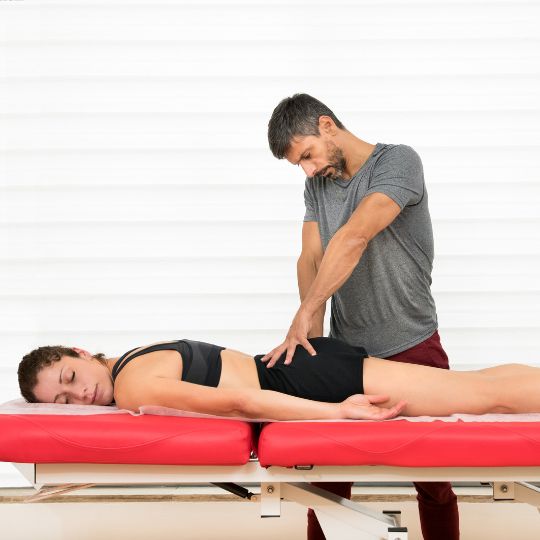Piriformis Syndrome is a common, painful musculoskeletal condition affecting the sciatic nerve. This condition is commonly mistaken for sciatica because most of the symptoms are similar; however, the origin of sciatica is different. Sciatica is caused from nerve entrapment stemming from the spinal cord. Piriformis Syndrome develops when the piriformis muscle compresses the sciatic nerve. The piriformis muscle is a deep hip flexor muscle situated in the gluteal region. It is positioned directly above the sciatic nerve. When this muscle remains in a tense, contracted state, it is likely to cause strain, muscle spasms, and inflammation. As a result, irritation and compression of the sciatic nerve is present, symptoms ranging from mild to excruciating.
THE MOST COMMON CAUSES OF PIRIFORMIS SYNDROME:
-
Over exercising/repetitive motions such as long distance running or cycling.
-
Failure to properly warm up before physical activity
-
Failure to properly stretch after physical activity.
-
Sitting for prolonged periods of time.
-
Trauma to hip/gluteal region from surgery or fall.
-
Lifting something improperly and damaging the piriformis muscle.
THE MOST COMMON SYMPTOMS OF PIRIFORMIS SYNDROME:
-
Aching, burning, throbbing pain in the gluteal region that often radiates down the back of the leg to the calf and sometimes the foot.
-
Pain worsens following physical activity such as walking, running cycling, or any activity involving repetitive hip/thigh motion.,
-
The pain makes sitting for long periods of time challenging.
-
Some may feel weakness or difficulty moving the leg.
BENEFITS OF MASSAGE FOR PIRIFORMIS SYNDROME:
-
Stretch, loosen, and elongate piriformis and surrounding muscles.
-
Reduce the pressure on the sciatic nerve by deactivating spasms.
-
Improve function in glute, hip, and leg on the affected side.
-
Alleviates local and referred pain.
-
Regular maintenance massage can prevent onset of piriformis syndrome.
WHAT TO EXPECT DURING A MASSAGE SESSION:
The therapist will begin with a thorough consultation. You may find it helpful to jot down pertinent information before your appointment. This should include the onset of your condition, frequency, pain level, exacerbating factors, and anything else you feel is relevant to your condition.
The therapist will assess the involved muscles and tissues to help determine the best course of action.
Based on the assessment, the therapist will apply various techniques such as Swedish massage, deep massage, myofascial release, trigger point therapy, heat therapy, and stretch therapy. The therapist will likely take a more conservative approach during the first session. The pressure will increase to the clients comfort level and tolerance.
Following the first session,the therapist will create an individualized treatment plan and a daily self-care regimen consisting of stretch and strength exercises.
SELF-CARE FOR PIRIFORMIS SYNDROME RELIEF:
While sitting down or lying on your back, place a tennis ball or lacrosse ball under the affected glute. As you remain fully relaxed, let gravity take over and sink into that ball for 10-15 minutes. It may be helpful to engage circular motion near the end to help break up scar tissue. A foam roller is great as well! It is normal to experience discomfort; however, it should not be painful. Deep breathing techniques will help with relaxation.
While lying on your back, bend your knees with feet flat on the floor. On the affected side, cross your ankle over your other knee to create a figure 4. Take your palm and gently press your knee away from you for at least a minute. Repeat this stretch a few times at least twice a day. It is normal to feel slight discomfort.
While lying on your back, use a yoga strap, band, or roll up a towel and place it just under the ball of your foot. Hold each end of your chosen assistive device and slowly bring your leg up to stretch your hamstring. Knee should have a slight bend and your leg should be fully supported for a nice passive stretch. Bring your leg up until you feel the stretch. Hold for at least 30 sec. Repeat several times daily.
It is important to take a break from strenuous exercise during the healing process. Walking is a nice, low-impact form of exercise. This will help strengthen and reduce tightness in your piriformis.
If you are suffering from piriformis syndrome, SUFFER NO MORE!! A skilled therapist will incorporate a variety of massage and stretch techniques to relax the piriformis muscle and surrounding muscles and tissue. This will reduce scar tissue build up, reduce tension, reduce muscle spasms, and manipulate the muscles back to their normal length. The sciatic nerve will be free from piriformis compression and inflammation. When committing to a treatment plan and daily self-care, restoration and overall well-being is achievable.





